St George’s Day at Zeebrugge
- Home
- World War I Articles
- St George’s Day at Zeebrugge
One of the reasons for Britain and her Empire going to war in 1914 was because of the perceived danger to the UK’s maritime trade posed by a hostile Germany controlling the ports on the European side of the English Channel and North Sea. The German conquest of much of Belgium, including the Belgian coast line, brought about this feared scenario with the result of much effort being expended by the Royal Navy in keeping the shipping lanes to France safe from enemy U-boats.
The inland port of Bruges was recognised by the Germans as a vital asset when it was captured in 1914. Connected to the North Sea by a series of canals that led to the ports of Zeebrugge and Ostend, Bruges became a base for German submarines, small destroyers and torpedo boats. Because it was six miles from the sea, the town was safe from bombardment from British warships on the coast.
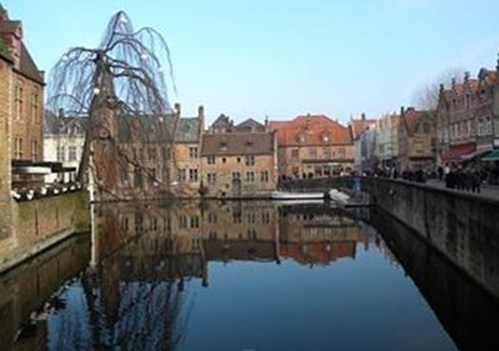
When, in early 1917, the Germans adopted a policy of unrestricted submarine warfare, Admiral Jellicoe (the First Sea Lord) took a pessimistic view of Britain’s ability to survive and plans were advanced for dealing with the German strategy. Whilst adopting the convoy system reduced the threat from German submarines, the desire to clear the Belgian coast to some extent influenced the decision to launch the Third Battle of Ypres which – had it gone to plan – would have removed the threat posed by the German base at Bruges.
Plans made
Appointed to the head of the Dover Patrol on 1 January 1918, Vice Admiral Sir Roger Keyes developed existing plans for an attack on the ports of Zeebrugge and Ostend. If the canals in these two ports could be blocked, the German submarine base at Bruges would be neutralised.
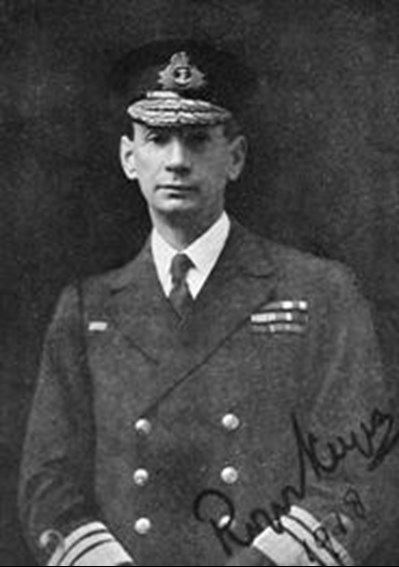
Above: Sir Roger Keyes.
The plan was approved by the Admiralty in February 1918 and the ships and crews were assembled. The raid was to be led by HMS Vindictive, an obsolete cruiser. The Vindictive was modified for the attack, most of her guns were replaced by mortars, howitzers, and flame-throwers. Other modifications included the fitting of ramps to enable troops to rapidly disembark.
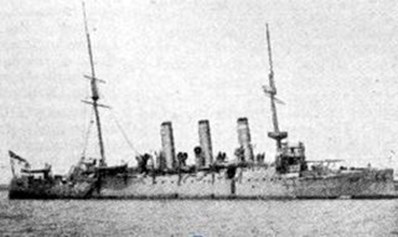
Above: HMS Vindictive
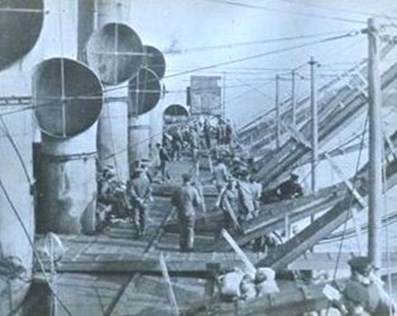
Above: the deck of Vindictive after modification, showing the ramps
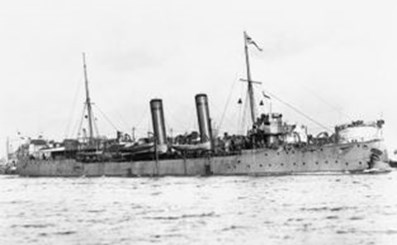
Above: HMS Thetis
Keyes’ plan was for the 1½ mile-long Mole at Zeebrugge to be stormed, neutralising the German defenders and so allowing block ships (Thetis, Iphigenia, Brilliant, Intrepid and Sirius – all obsolete cruisers of the same “Apollo” class built in the 1890’s) to enter the canals and there to be sunk.
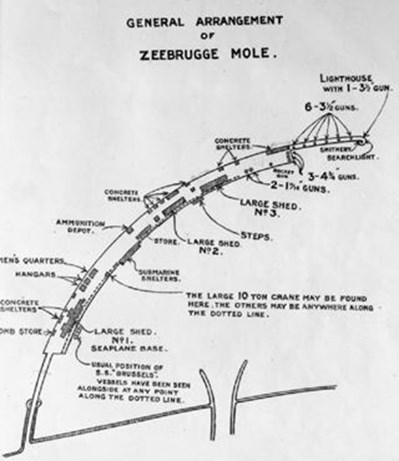
Above: The plan of the Mole at Zeebrugge.
Amongst the flotilla were two unlikely vessels. These were the Mersey ferries, the Iris and the Daffodil. Selected because they had a shallow draught and double hulls, the ferries were stripped of all unnecessary equipment and fitted with protective armour.
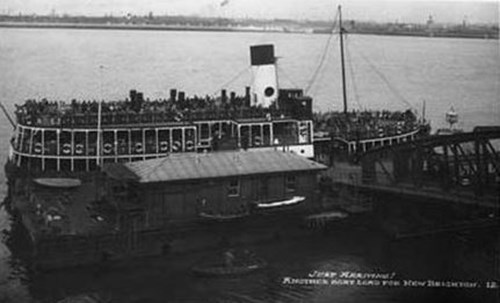
Above: The Daffodil
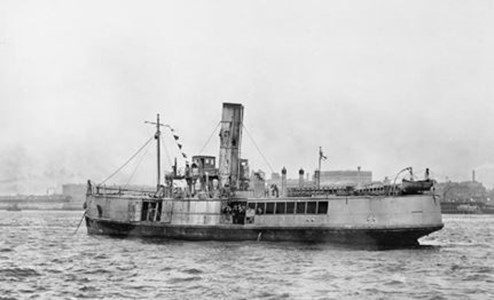
Above: The Iris, on the return from the Zeebrugge raid.
In command of the naval parties that were to storm onto the mole from the Iris was thirty year old Lt-Commander George Bradford. One of four brothers, George had already lost his younger brother, James, who had been awarded the Military Cross whilst serving as a Second Lieutenant with the Durham Light Infantry. A second brother, Roland, had been awarded the Victoria Cross and promoted to Brigadier General, but had also lost his life. It must have been with mixed feelings that George learned that the attack was to take place on 23 April, his 31st birthday – St George’s Day.
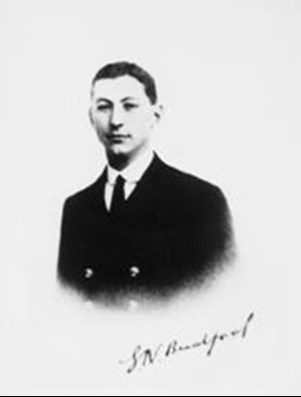
Above: Lt-Commander George Bradford. (IWM)
It was recognised that one of the most critical parts of the operation was on the approach to the port of Zeebrugge when the flotilla needed be masked from the view of the shore batteries. It was therefore decided that a smokescreen should be laid. This smokescreen was devised by Wing Commander Brock of the Royal Naval Air Service.
Brock is a very interesting character. Born into a family who manufactured fireworks; at school he blew up a stove whilst experimenting with explosives. Originally commissioned into the Royal Artillery, he was loaned to the Royal Naval Air Service and formally transferred to the RNVR at the end of 1914. He was a member of the Admiralty Board of Inventions and Research and had founded, organised and commanded the Royal Navy Experimental Station at Stratford.
Among his many developments were the Dover Flare and the Brock Anti-Zeppelin Bullet (the first German airship to be shot down was destroyed by this bullet).
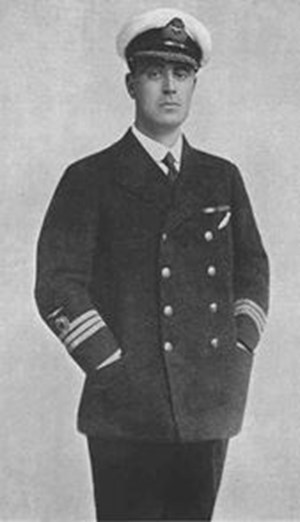
Above: Wing Commander Frank Brock
By 1918 he had been promoted to Wing Commander and awarded the OBE. His new invention – a smokescreen (or "artificial fog" as he preferred to call it) was to be used on the raid.
Essentially, a chemical mixture was injected directly under pressure into the hot exhausts of the motor torpedo boats and other small craft, or the hot interior surface of the funnels of destroyers. The larger ships each had welded iron contraptions, in the region of ten feet in height, hastily assembled at Chatham. These were fed with solid cakes of phosphide of calcium. Dropped into a bucket-like container full of water, the resulting smoke and flames roared up a chimney and were dispersed by a windmill arrangement. It was more toxic than its predecessor. Taking in a lungful was an extremely unpleasant experience.
Deborah Lake, The Zeebrugge and Ostend Raids 1918 (Barnsley: Pen and Sword, 2002)
Brock accompanied the ships and brought on board with him a box marked ‘Highly Explosive, Do Not Open’ which actually contained bottles of vintage port which were drunk by his men.
The plan also involved two old submarines (HMS C1 and HMS C3) each packed with five tons of explosive which were to be used to blow up part of the mole. Manned with volunteer crews, they were instructed to attack the ‘viaduct’ section that linked the shore to the rest of the mole.
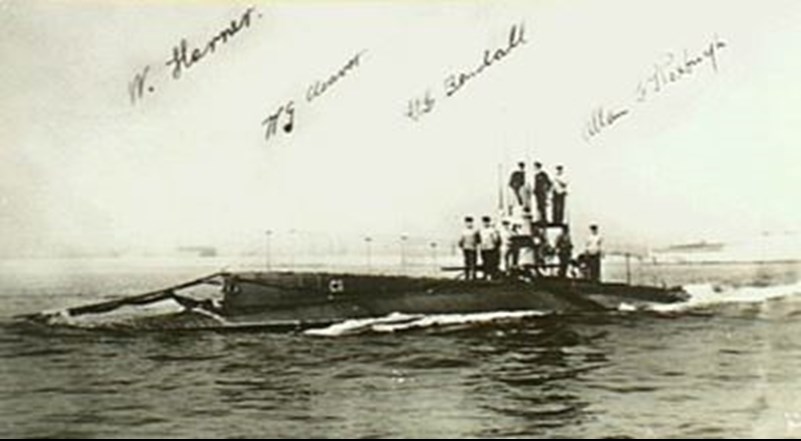
Above: HMS C3
The destruction of the viaduct was intended to prevent reinforcement of the German garrison on the mole. The crews were to abandon their submarines shortly before the collision with the viaduct, leaving the submarines to steer themselves automatically. Unfortunately, during the crossing from Dover, C1 parted with her tow and arrived too late to take part in the operation.
As the flotilla, led by HMS Vindictive, approached Zeebrugge, the wind changed direction and the smoke screen did not work as intended. As a result, Vindictive came under heavy fire and was forced to the wrong part of the mole – resulting in the 200 or so Royal Marines coming ashore in the incorrect place. The Marines were unable to silence the German guns and consequently suffered heavy casualties. Meanwhile, submarine C3, commanded by Lt Sandford, headed towards the viaduct and successfully destroyed this section.
Back at the Mole, Daffodil was hit in the engine room by two shells, but was able to maintain her position, holding Vindictive against the wall of the Mole.
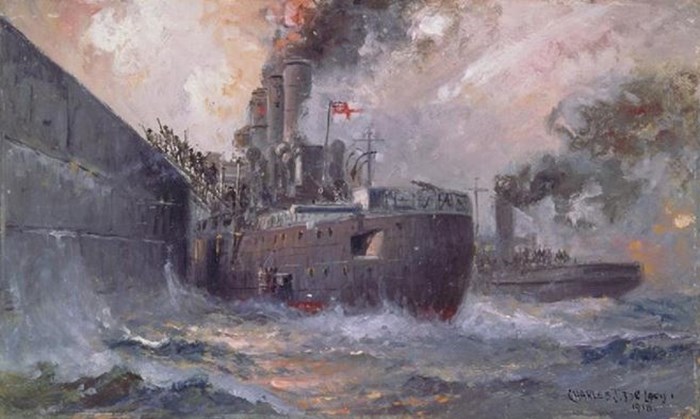
Above: The 'Vindictive at Zeebrugge: The storming of Zeebrugge Mole
Iris, however, was coming under heavy fire. Her first attempt to off-load her party of Royal Marines failed as the hooks she was to use to hold her onto the mole were not large enough. In an attempt to fix the hooks to the mole, Lt-Commander George Bradford and Lt Hawkins climbed ashore. Both men were killed. Further fatalities occurred when a shell hit the Iris bursting amongst a group of 56 Marines who were preparing to come ashore; 49 were killed and others seriously injured.
Elsewhere, the main part of the operation - the sinking of the concrete-filled blockships - was in difficulty. The failure of the attack on the mole resulted in heavy German fire being directed onto the blockships; HMS Thetis did not make it to the canal entrance and was scuttled prematurely. Intrepid and Iphigenia were, however, successfully scuttled at the narrowest point of the canal.
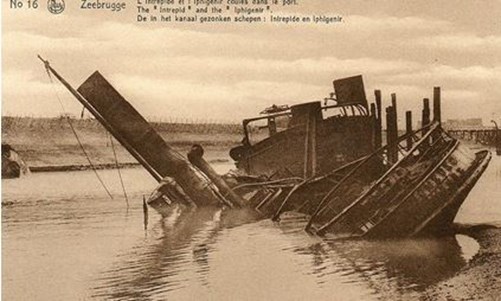
Above: HMS Iphigenia scuttled at the entrance of the canal system
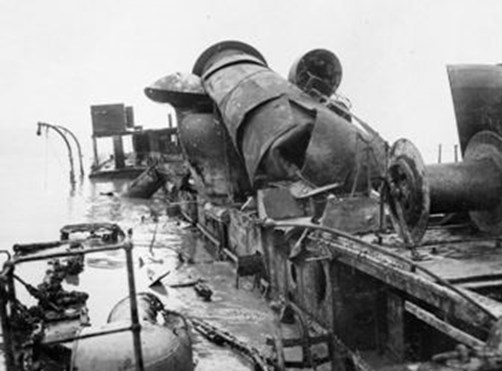
Above: HMS Thetis, scuttled in Zeebrugge Harbour. Image IWM
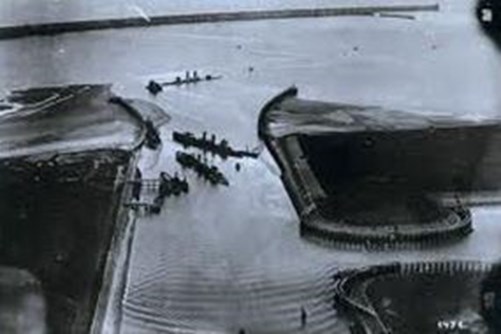
Above: The blocking of the canal at Zeebrugge. In the foreground are HMS Intrepid and HMS Iphigenia, further away from the camera is HMS Thetis
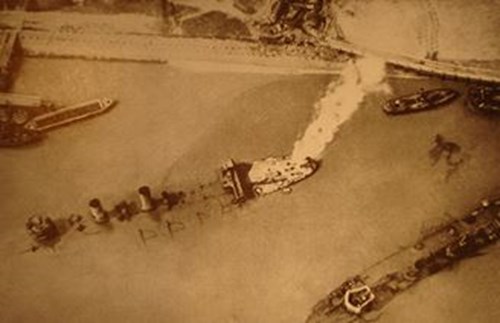
Above: another view showing the positions of HMS Intrepid and HMS Iphigenia: clearly the canal was not totally blocked despite the heroism shown.
Frank Brock, meanwhile, was desperate to discover the secret of the German system of sound-ranging. He obtained permission to go ashore, and joined a storming party on the Mole. Within moments he was killed in action.
Aftermath
Although two blockships were sunk at a narrow part of the entrance to the canal network, these were not in the correct positions, and by dismantling two piers near HMS Intrepid and HMS Iphigenia, the Germans were able to create a channel around the obstacle. The block was only effective for a couple of days, after which submarines were able to negotiate their way around the wrecked ships at high tide.
The Zeebrugge Raid was promoted by the Allies as a British victory and resulted in the awarding of eight Victoria Crosses. Of the 1,700 men involved in the operation, 300 men were wounded while more than 200 were killed.
HMS Vindictive made it back to the UK, having sustained a large amount of damage on her superstructure.
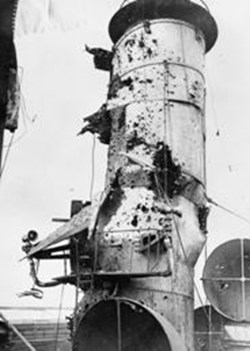
Above: Damage caused to one of Vindictive’s funnels during the St George’s day raid. Image courtesy of the IWM
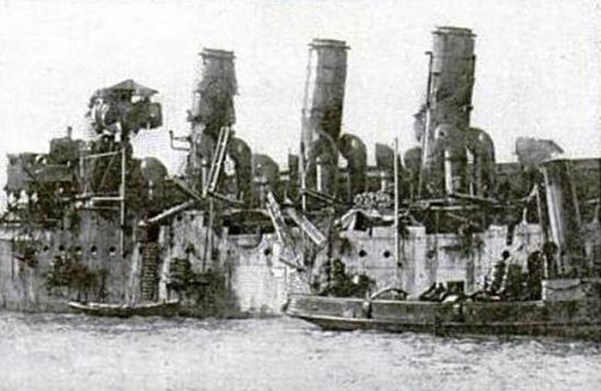
Above: HMS Vindictive back in port after the raid.
The Zeebrugge Raid: Victoria Cross Awards
Details of the citations for the eight VCs awarded
Major Edward Bamford, RMLI
On 22nd/23rd April 1918 at Zeebrugge, Belgium, Captain Bamford landed on the Mole from HMS Vindictive with three platoons of the Royal Marines storming force in the face of great difficulties. When on the Mole and under heavy fire, he commanded his company with total disregard of personal danger and he showed a magnificent example to his men. He first established a strong point on the right of the disembarkation and when satisfied that it was safe, led an assault on the battery to the left.
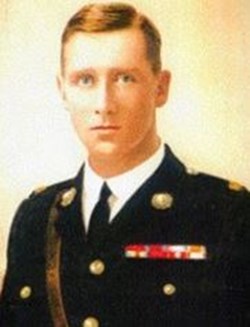
Captain Alfred Carpenter
For most conspicuous gallantry. This officer was in command of "Vindictive." He set a magnificent example to all those under his command by his calm composure when navigating mined waters, bringing his ship alongside the mole in darkness. When "Vindictive" was within a few yards of the mole the enemy started and maintained a heavy fire from batteries, machine guns and rifles on to the bridge. He showed most conspicuous bravery, and did much to encourage similar behaviour on the part of the crew, supervising the landing from the "Vindictive" on to the mole, and walking round the decks directing operations and encouraging the men in the most dangerous and exposed positions. By his encouragement to those under him, his power of command and personal bearing, he undoubtedly contributed greatly to the success of the operation. Capt. Carpenter was selected by the officers of the "Vindictive," "Iris," and "Daffodil," and of the naval assaulting force to receive the Victoria Cross under Rule 13 of the Royal Warrant, dated the 29th January, 1856.
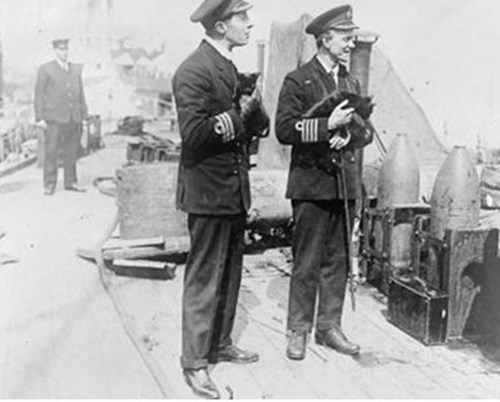
Above: Captain Carpenter (on the right)
Lieutenant Percy Dean
On 22 and 23 April 1918 at Zeebrugge, Belgium, after Intrepid and Iphigenia had been scuttled, their crews were taken off by Motor Launch 282 commanded by Lieutenant Dean. He embarked more than 100 officers and men under constant and deadly fire from heavy and machine-guns at point blank range. This complete, he was about to clear the canal when the steering gear broke down, so he manoeuvred on his engines and was actually clear of the entrance to the harbour when he was told there was an officer in the water. He immediately turned back and rescued him.
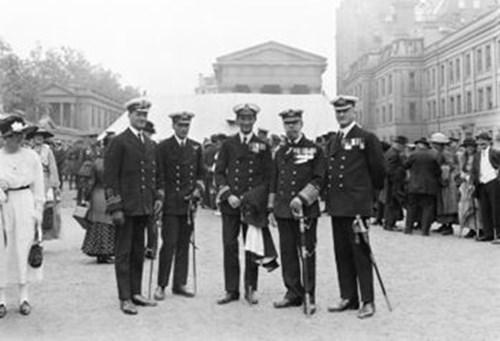
Above: A group of Naval VC's at a party given for holders of the Victoria Cross by King George V at Wellington Barracks. On the left is Percy Dean, then comes Gordon Steele and Augustus Agar who were both awarded the VC for actions in Russia in 1919. Next is Arthur Wilson whose VC was awarded in the Sudan in 1884. On the right is the famous Edward Unwin, awarded the VC for his actions during the landings from the River Clyde, at Gallipoli on 25 April 1915.
Giving a lecture in January 1936 at the Royal United Service Institution, Dean gave an account of the raid. He told that when manoeuvring his Motor Launch close to the Mole after the steering gear had malfunctioned, he looked up to see German gunners just above him. He had half a dozen revolvers on the bridge and as the launch moved past he fired one revolver after another at the Germans. As the launch slipped away he ordered a smoke bomb to be dropped, thus allowing it to escape under the cover of the smoke.
Sergeant Norman Finch, Royal Marines
On 22/23 April 1918 at Zeebrugge, Belgium, Sergeant Finch was second in command of the pom-poms and Lewis gun in the foretop of HMS Vindictive. At one period Vindictive was being hit every few seconds, but Sergeant Finch and the officer in command kept up a continuous fire, until two heavy shells made direct hits on the foretop killing or disabling everyone except Sergeant Finch who was, however, severely wounded. Nevertheless he remained in his battered and exposed position, harassing the enemy on the Mole until the foretop received another direct hit, putting the remainder of the armament completely out of action. His award was by virtue of ballot. He retired with the rank of Quartermaster Sergeant in December 1929.
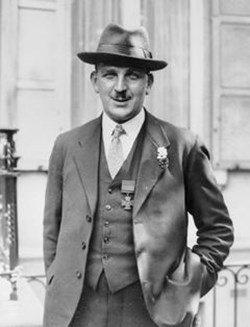
Above: Norman Finch
Able Seaman Albert McKenzie
For most conspicuous gallantry. This rating belonged to ‘B’ Company of storming party. On the night of the operation he landed on the mole with his machine-gun in the face of great difficulties, and did very good work, using his gun to the utmost advantage. He advanced down the mole with Lieut. Comdr. Harrison, who with most of his party was killed, and accounted for several of the enemy running from a shelter to a destroyer alongside the mole. This very gallant seaman was severely wounded whilst working his gun in an exposed position. Able Seaman McKenzie was selected by the men of the 'Vindictive,' 'Iris' and 'Daffodil,' and of the naval assaulting force to receive the Victoria Cross under Rule 13 of the Royal Warrant dated the 29th January, 1856.
He was presented with his VC by King George V at Buckingham Palace, and after almost recovering from his wounds he died of influenza during the world ‘flu pandemic in October 1918. McKenzie is buried in Camberwell Old Cemetery.
Lieutenant Richard Sandford
On 22/23 April 1918 at Zeebrugge, Belgium, Lieutenant Sandford commanding HM Submarine C.3, skilfully placed the vessel between the piles of the viaduct which connected the Mole with the shore, before laying his fuse and abandoning her. He disdained to use the gyro steering which would have enabled him and his crew to abandon the submarine at a safe distance, but preferred to make sure that his mission would be successful.
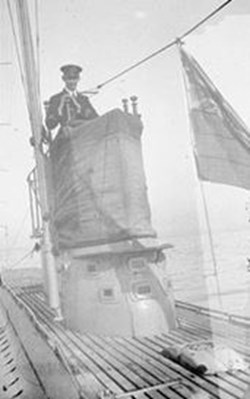
Sandford on board HMS C3
Lieutenant-Commander Arthur Harrison
For most conspicuous gallantry at Zeebrugge on the night of the 22nd-23rd April, 1918. This officer was in immediate command of the Naval Storming Parties embarked in 'Vindictive'. Immediately before coming alongside the Mole, Lieut.-Commander Harrison was struck on the head by a fragment of a shell which broke his jaw and knocked him senseless. Recovering consciousness he proceeded on to the Mole and took over command of his party, who were attacking the seaward end of the Mole. The silencing of the guns on the Mole head was of the first importance, and though in a position fully exposed to the enemy's machine-gun fire Lieut.-Commander Harrison gathered his men together and led them to the attack. He was killed at the head of his men, all of whom were either killed or wounded. Lieut.-Commander Harrison, though already severely wounded and undoubtedly in great pain, displayed indomitable resolution and courage of the highest order in pressing his attack, knowing as he did that any delay in silencing the guns might jeopardise the main object of the expedition, i.e., the blocking of the Zeebrugge-Bruges Canal.
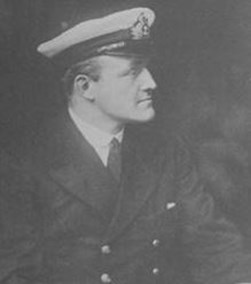
Above: Arthur Harrison
Lieutenant-Commander George Bradford
For most conspicuous gallantry at Zeebrugge on the night of the 22nd-23rd April, 1918. This Officer was in command of the Naval Storming Parties embarked in Iris II. When Iris II proceeded alongside the Mole great difficulty was experienced in placing the parapet anchors owing to the motion of the ship. An attempt was made to land by the scaling ladders before the ship was secured. Lieutenant Claude E. K. Hawkings (late Erin) managed to, get one ladder in position and actually reached the parapet, the ladder being crushed to pieces just as he stepped off it. This very gallant young officer was last seen defending himself with his revolver. He was killed on the parapet. Though securing the ship was not part of his duties, Lieut.-Commander Bradford climbed up the derrick, which carried a large parapet anchor and was rigged out over the port side; during this climb the ship was surging up and down and the derrick crashing on the Mole. Waiting his opportunity he jumped with the parapet anchor on to the Mole and placed it in position. Immediately after hooking on the parapet anchor Lieut.-Commander Bradford was riddled with bullets from machine guns and fell into the sea between the Mole and the ship. Attempts to recover his body failed. Lieut.-Commander Bradford’s action was one of absolute self-sacrifice; without a moment’s hesitation he went to certain death, recognising that in such action lay the only possible chance of securing Iris and enabling her storming parties to land.
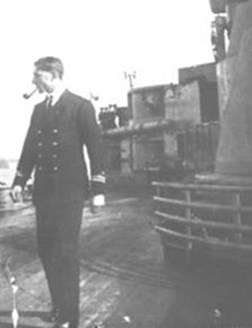
Above: George Bradford in an undated photograph.
The Bradford family are unique in having brothers each awarded the VC during the First World War. George was the third of the brothers to be killed, The fourth brother, Thomas Bradford, was wounded in the Second Battle of Ypres (1915), twice Mentioned in Despatches and was awarded the D.S.O. before being appointed to the staff – becoming a Staff Captain and later a Brigade Major. Thomas survived the war

Above: The four Bradfords.
Commonwealth War Graves Commission Cemeteries
George Bradford is buried in Blankenberge Town Cemetery which contains just four graves of men from the Zeebrugge raid.
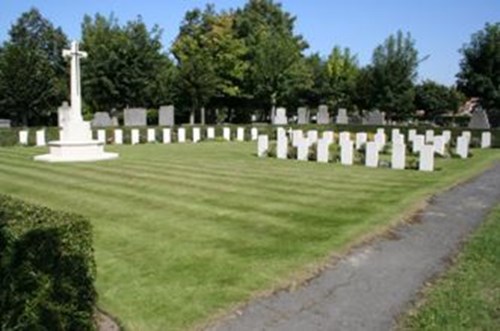
The body of Wing Commander Frank Brock was never recovered and he is therefore commemorated on the Zeebrugge Memorial which is one of the smallest ‘memorials to the missing’ that the commission has responsibility for. This memorial is within the CWGC plot at Zeebrugge Churchyard.
Below: Zeebrugge Churchyard and the Zeebrugge Memorial.
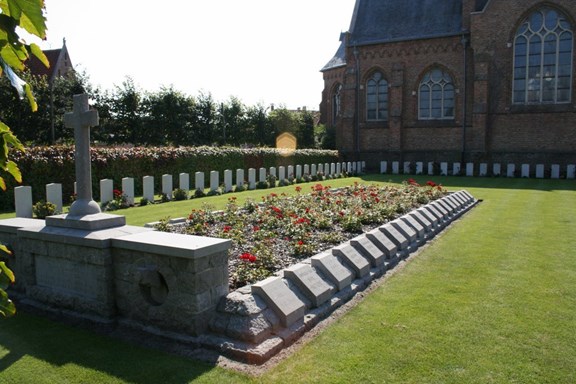
The bodies of over sixty of the fatalities of the raid were brought back to the UK and are now buried (or commemorated in the case of nine of these) at Dover (St James's) Cemetery (below).
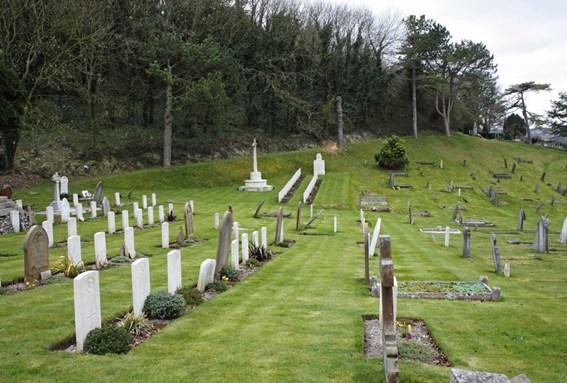
The Vindictive was used for one more operation, being scuttled in a raid on Ostend a few weeks later. Raised in 1920, her bow section is now preserved at Ostend.
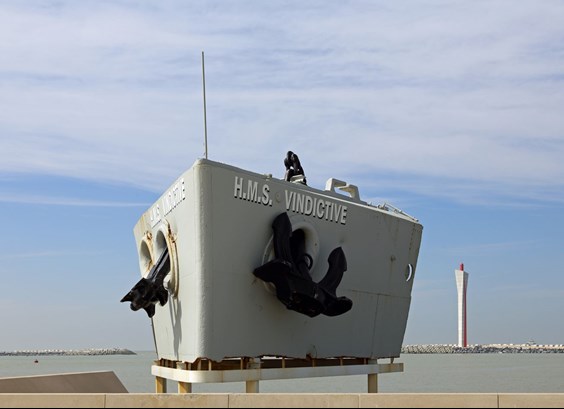
Article by David Tattersfield, Vice-Chairman, The Western Front Association
Further reading:
Passchendaele and the Flanders U-Boats





